Liquid Phase Sintering of Al Powder Using Al-X (X=Cu, Ca, Mg) Eutectic Alloy Powders: Effect of Alloy Elements and Oxide Film Thickness
Abstract
1. Introduction
2. Experimental Procedure
2.1. Selecting Elements in Eutectic Alloy Powder, Sintering Temperature, and Blending Compositions
2.2. Sample Preparation and Evaluation
3. Results
3.1. Sintering Behavior and Microstructure of Samples Sintered Using As-Supplied Al Powder
3.2. Sintering Behavior and Microstructure of Samples Sintered Using Oxidation Heat-Treated Al Powder
4. Discussion
5. Conclusions
- Sintering using as-supplied Al powder at 630 °C/1800 s resulted in a high relative density of 96–97% when the Al-Cu and Al-Ca aids were used. However, when the Al-Mg aid was used, the relative density was limited to approximately 80%.
- The eutectic structures (assuming the liquid phase during the sintering) were observed when the Al-Cu and Al-Ca aids were used, while no eutectic structure was observed, and Mg was uniformly distributed when Al-Mg aid was used.
- The homogenization of the α single phase during the cooling process would be the reason why Mg is uniformly distributed when the Al-Mg aid is used. The wide temperature range from the solidus temperature to the eutectic temperature would provide sufficient time to diffuse Mg to the center of the α-grain, causing the formation of pores at the areas where the liquid phase existed.
- When Al powder was heat-treated at 550 °C to thicken the oxide film to approximately 50 nm and subsequently sintered at 630 °C/1800 s using Al-Cu or Al-Ca aids, densification hardly progressed. Al powder with a significantly grown oxide film on the surface is difficult to sinter using eutectic alloy powders.
- When Al powder was heat-treated at 400–450 °C to thicken the oxide film to approximately 4 nm and subsequently sintered at 630 °C/1800 s, the densification and grain growth occurred using the Al-Cu aid, but the relative density and grain growth of the sample sintered using the Al-Ca aid were significantly suppressed. This would be due to the oxides produced by the reaction of Ca and Al2O3, which would inhibit the progress of sintering and grain growth.
- It can be concluded that the Al-Cu aid, which is relatively insensitive to the oxidation state of the Al powder surface and can achieve a high relative density, is the most appropriate liquid phase sintering aid among those investigated in this study.
Author Contributions
Funding
Data Availability Statement
Conflicts of Interest
References
- Frazier, W.B. Metal Additive Manufacturing: A Review. J. Mater. Eng. Perform. 2014, 23, 1917–1928. [Google Scholar] [CrossRef]
- Singh, D.D.; Mahender, T.; Reddy, A.R. Powder bed fusion process: A brief review. Mater. Today 2021, 46, 350–355. [Google Scholar] [CrossRef]
- Svetlizky, D.; Das, M.; Zheng, B.; Vyatskikh, A.L.; Bose, S.; Bandyopadhyay, A.; Schoenung, J.M.; Lavernia, E.J.; Eliaz, N. Directed energy deposition (DED) additive manufacturing: Physical characteristics, defects, challenges and applications. Mater. Today 2021, 49, 271–295. [Google Scholar] [CrossRef]
- Ziaee, M.; Crane, N.B. Binder jetting: A review of process, materials, and methods. Addit. Manuf. 2019, 28, 781–801. [Google Scholar] [CrossRef]
- Gonzalez-Gutierrez, J.; Cano, S.; Schuschnigg, S.; Kukla, C.; Sapkota, J.; Holzer, C. Additive Manufacturing of Metallic and Ceramic Components by the Material Extrusion of Highly Filled Polymers: A Review and Future Perspectives. Materials 2018, 11, 840. [Google Scholar] [CrossRef]
- Stevens, E.; Schloder, S.; Bono, E.; Schmidt, D.; Chmielus, M. Density variation in binder jetting 3D-printed and sintered Ti-6Al-4V. Addit. Manuf. 2018, 22, 746–752. [Google Scholar] [CrossRef]
- Mostafaei, A.; Stevens, E.L.; Hughes, E.T.; Biery, S.D.; Hilla, C.; Chmielus, M. Powder bed binder jet printed alloy 625: Densification, microstructure and mechanical properties. Mater. Des. 2016, 108, 126–135. [Google Scholar] [CrossRef]
- Chen, Z.; Chen, W.; Chen, L.; Zhu, D.; Chen, Q.; Fu, Z. Influence of initial relative densities on the sintering behavior and mechanical behavior of 316 L stainless steel fabricated by binder jet 3D printing. Mater. Today Commun. 2022, 31, 103369. [Google Scholar] [CrossRef]
- Kumar, A.Y.; Wang, J.; Bai, Y.; Huxtable, S.T.; Williams, C.B. Impacts of process-induced porosity on material properties of copper made by binder jetting additive manufacturing. Mater. Des. 2019, 182, 108001. [Google Scholar] [CrossRef]
- Marczyk, J.; Ostrowska, K.; Hebda, M. Influence of binder jet 3D printing process parameters from irregular feedstock powder on final properties of Al parts. Adv. Powder Technol. 2022, 33, 103768. [Google Scholar] [CrossRef]
- Hudson, E.; Fidan, I. The development of a framework to produce additively manufactured, low-cost aluminum via material extrusion process. Int. J. Interact. Des. Manuf. 2024, 18, 4867–4876. [Google Scholar] [CrossRef]
- Im, S.; Ghasri-Khouzani, M.; Muhammad, W.; Batmaz, R.; Esmati, K.; Chakraborty, A.; Natarajan, A.; Martin, É. Evaluation of Different Sintering Agents for Binder Jetting of Aluminum Alloy. J. Mater. Eng. Perform. 2023, 32, 9550–9560. [Google Scholar] [CrossRef]
- Yamaguchi, D.; Oya, N. X-ray observation study of the influence of binder deposition on sintering process of aluminum binder jetting. Int. J. Adv. Manuf. Technol. 2023, 128, 1981–1990. [Google Scholar] [CrossRef]
- Oya, N.; Sato, T.; Yamaguchi, D.; Yamaguchi, D.; Shinagawa, K. Finite element analysis of sintering deformation in aluminum finned heatsink printed by binder jetting. Int. J. Adv. Manuf. Technol. 2024, 133, 3901–3912. [Google Scholar] [CrossRef]
- Momeni, H.; Ravavi, H.; Shabestari, S.G. Effect of supersolidus liquid phase sintering on microstructure and densification of the Al-Cu-Mg pre-alloyed powder. Iran. J. Mater. Sci. Eng. 2011, 8, 10–17. [Google Scholar]
- Zhaoji Yu, L.W.; Liu, C.; Ma, Y.; Huang, Y.; Wang, T.; Yang, L.; Yan, H.; Liu, W. Microstructure and tensile properties of aluminum powder metallurgy alloy prepared by a novel low-pressure sintering. J. Mater. Res. Technol. 2021, 14, 1419–1429. [Google Scholar] [CrossRef]
- Rusin, N.M.; Skorentsev, A.L. Mechanical and Tribological Properties of Sintered Aluminum Matrix Al–Sn Composites Reinforced with Al3Fe Particles. Phys. Met. Metallogr. 2021, 122, 1248–1255. [Google Scholar] [CrossRef]
- Schaffer, G.B.; Sercombe, T.B.; Lumley, R.N. Liquid phase sintering of aluminium alloys. Mater. Chem. Phys. 2001, 67, 85–91. [Google Scholar] [CrossRef]
- Okamoto, H. A1-Zn (aluminum-zinc). J. Phase Equilib. 1995, 16, 281–282. [Google Scholar] [CrossRef]
- German, R.M.; Suri, P.; Park, S.J. Review: Liquid phase sintering. J. Mater. Sci. 2009, 44, 1–39. [Google Scholar] [CrossRef]
- Horng, C.; Lin, S.; Liu, K. Formation of MgAl2O4 in Al2O3-(Al-4wt.%Mg) composites. Mater. Sci. Eng. A 1992, 150, 289–294. [Google Scholar] [CrossRef]
- Lumley, R.N.; Sercombe, T.B.; Schaffer, G.M. Surface oxide and the role of magnesium during the sintering of aluminum. Metall. Mater. Trans. A 1999, 30, 457–463. [Google Scholar] [CrossRef]
- Savitskii, A.P.; Romanov, G.N. Effect of porosity on the volume changes experienced by Al-Cu compacts during liquid-phase sintering. Powder Metall. Met. Ceram. 1987, 26, 532–536. [Google Scholar] [CrossRef]
- Li, M.; Du, W.; Elwany, A.; Pei, Z.; Ma, C. Metal Binder Jetting Additive Manufacturing: A Literature Review. ASME J. Manuf. Sci. Eng. 2020, 142, 090801. [Google Scholar] [CrossRef]
- Rane, K.; Strano, M. A comprehensive review of extrusion-based additive manufacturing processes for rapid production of metallic and ceramic parts. Adv. Manuf. 2019, 7, 155–173. [Google Scholar] [CrossRef]
- Sucgang, A.T.; Cuzacq, L.; Bobet, J.; Lu, Y.; Silvain, J. Pressure-Less Liquid-Phase Sintering of Aluminum-Based Materials. J. Manuf. Mater. Process. 2025, 9, 4. [Google Scholar] [CrossRef]
- Nosko, M.; Nagy, Š.; Weber, L.; Maťko, I.; Mihalkovič, M.; Iždinský, K.; Orovčík, Ľ. Effect of Ca addition on interface formation in Al(Ca)/Al2O3 composites prepared by gas pressure assisted infiltration. Mater. Des. 2016, 108, 618–623. [Google Scholar] [CrossRef]
- Norbert, P.; Christian, L.; Richter, K.W. Re-investigation of phase equilibria in the system Al–Cu and structural analysis of the high-temperature phase η1-Al1-δCu. Intermetallics 2011, 19, 1737–1746. [Google Scholar] [CrossRef]
- Okamoto, H. Al-Mg (aluminum-magnesium. J. Phase Equilib. 1998, 19, 598. [Google Scholar] [CrossRef]
- Okamoto, H. Al-Ca (Aluminum-Calcium). J. Phase Equilib. 2003, 24, 580. [Google Scholar] [CrossRef]
- Kondoh, K.; Fujita, J.; Umeda, J.; Imai, H.; Enami, K.; Ohara, M.; Igarashi, T. Thermo-dynamic analysis on solid-state reduction of CaO particles dispersed in Mg–Al alloy. Mater. Chem. Phys. 2011, 129, 631–640. [Google Scholar] [CrossRef]
- Ogura, T.; Takata, S.; Takahashi, M.; Hirose, A. Effects of Reducing Solvent on Copper, Nickel, and Aluminum Joining Using Silver Nanoparticles Derived from a Silver Oxide Paste. Mater. Trans. 2015, 56, 1030–1036. [Google Scholar] [CrossRef]
- Jeurgens, L.P.H.; Sloof, W.G.; Tichelaar, F.D.; Mittemeijer, E.J. Structure and morphology of aluminium-oxide films formed by thermal oxidation of aluminium. Thin Solid Films 2002, 418, 89–101. [Google Scholar] [CrossRef]
- Özbilen, S.; Ünal, A.; Sheppard, T. Influence of Atomizing Gases on the Oxide-Film Morphology and Thickness of Aluminum Powders. Oxid. Met. 2000, 53, 1–23. [Google Scholar] [CrossRef]
- Neikov, O.D.; Vasilieva, G.D.; Sameljuk, A.V.; Krajnikov, A.V. Water atomised aluminium alloy powders. Mater. Sci. Eng. A 2004, 383, 7–13. [Google Scholar] [CrossRef]
- Du, Y.; Chang, Y.A.; Huang, B.; Gong, W.; Jin, Z.; Xu, H.; Yuan, Z.; Liu, Y.; He, Y.; Xie, F. Diffusion coefficients of some solutes in fcc and liquid Al: Critical evaluation and correlation. Mater. Sci. Eng. A 2003, 363, 140–151. [Google Scholar] [CrossRef]
- Magnusson, T.; Arnberg, L. Density and solidification shrinkage of hypoeutectic aluminum-silicon alloys. Metall. Mater. Trans. A 2001, 32, 2605–2613. [Google Scholar] [CrossRef]
- Venkatesh, A.M.; Bouvard, D.; Lhuissier, P.; Villanova, J. 3D analysis of ceramic powder sintering by synchrotron X-ray nano-tomography. J. Eur. Ceram. Soc. 2025, 43, 2553–2563. [Google Scholar] [CrossRef]
- Cheng, Y.; Miyawaki, T.; Wang, W.; Takata, N.; Suzuki, A.; Kobashi, M.; Kato, M. Laser-beam powder bed fusion of Al–Fe–Cu alloy to achieve high strength and thermal conductivity. Addit. Manuf. Lett. 2024, 8, 100191. [Google Scholar] [CrossRef]
- Román, A.S.; Méndez, C.M.; Gervasi, C.A.; Rebak, R.B.; Ares, A.E. Corrosion Resistance of Aluminum-Copper Alloys with Different Grain Structures. J. Mater. Eng. Perform. 2021, 30, 131–144. [Google Scholar] [CrossRef]
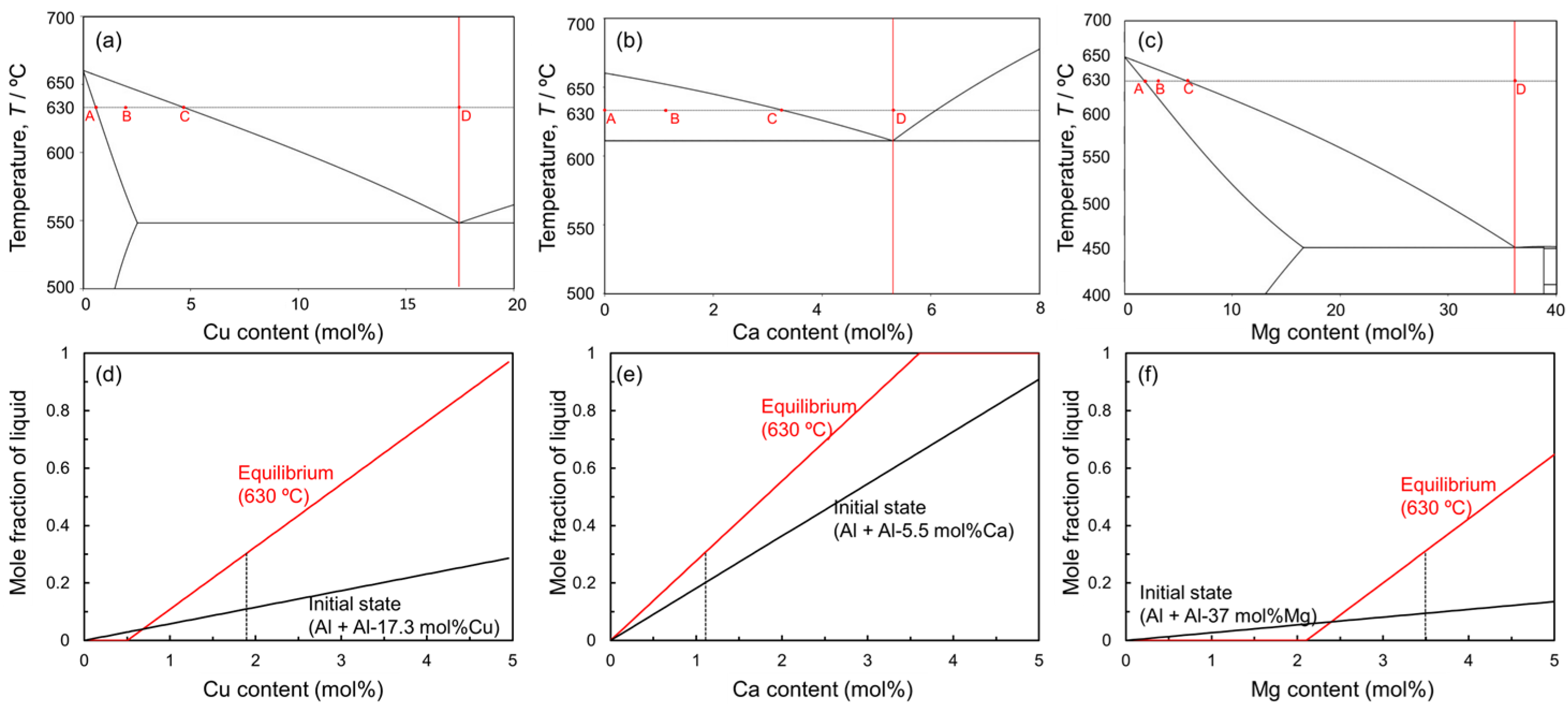


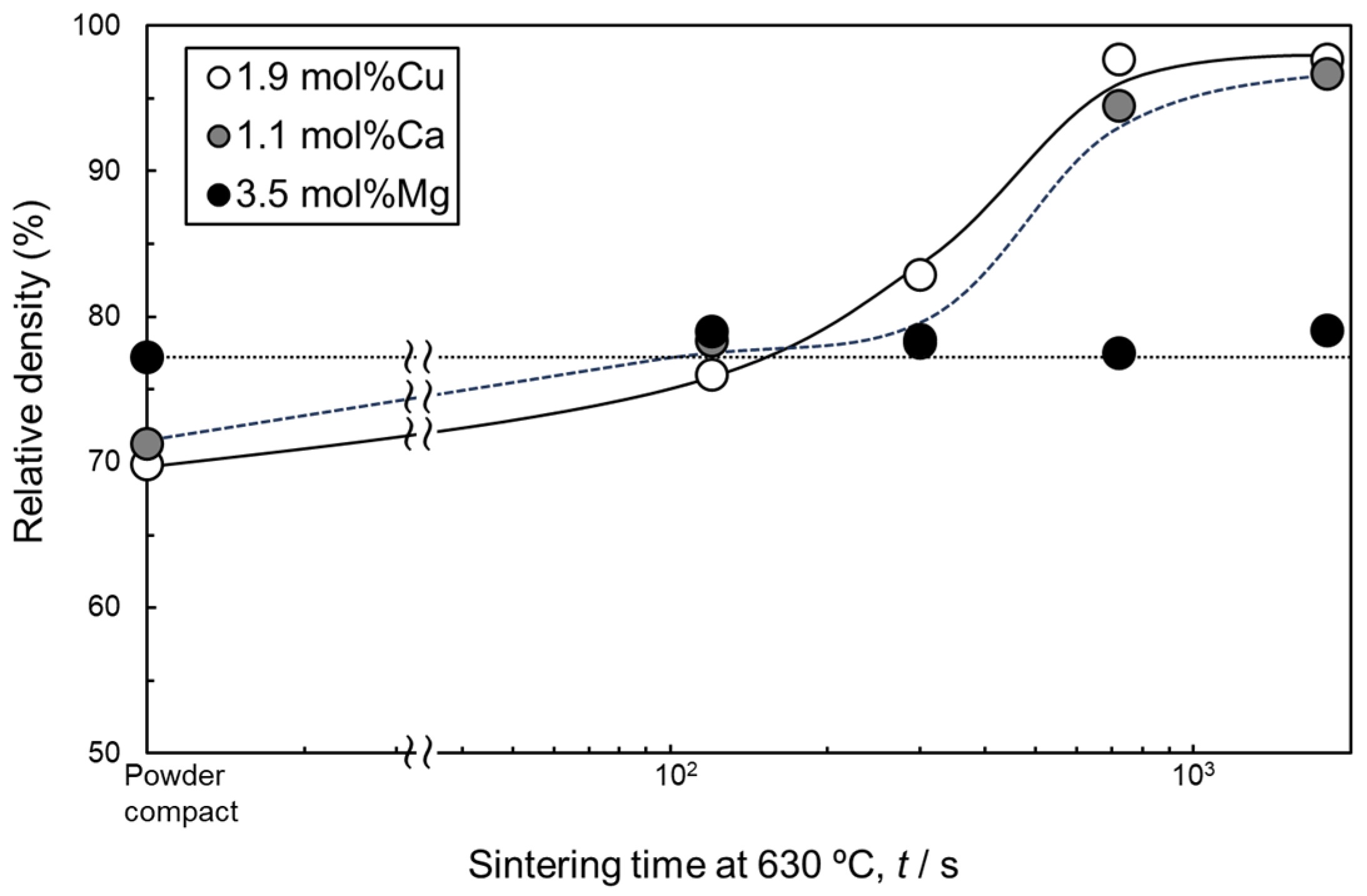

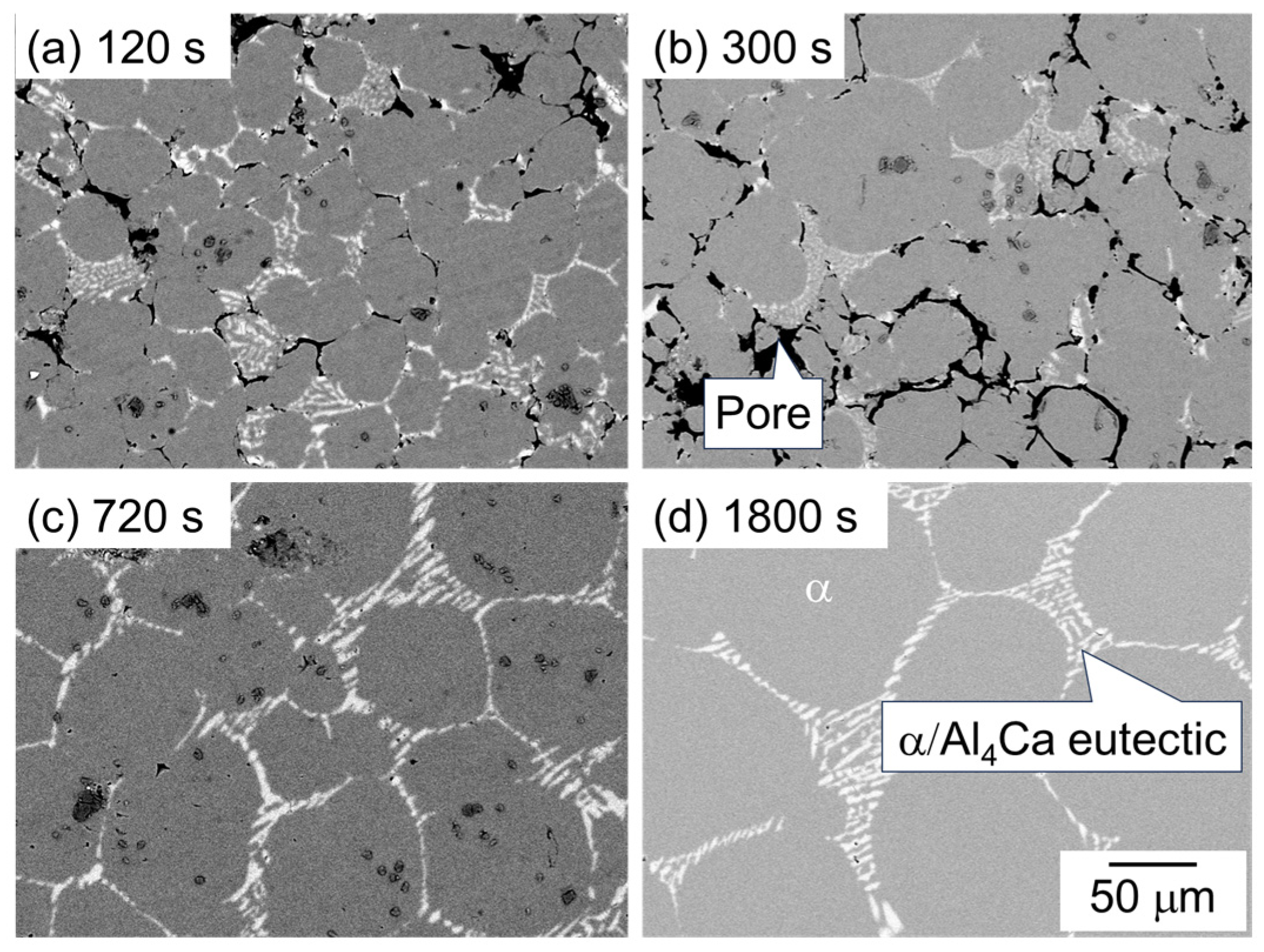
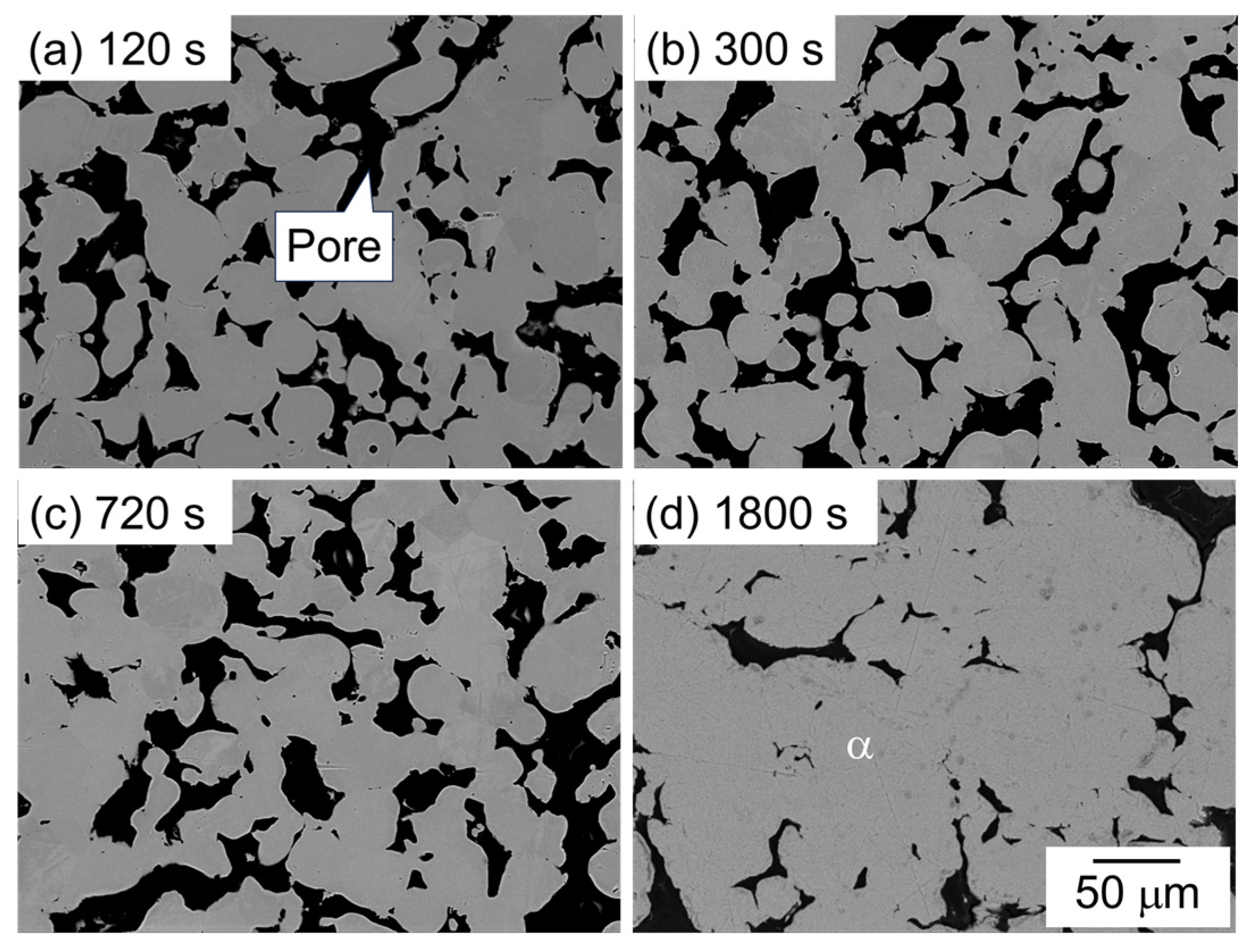
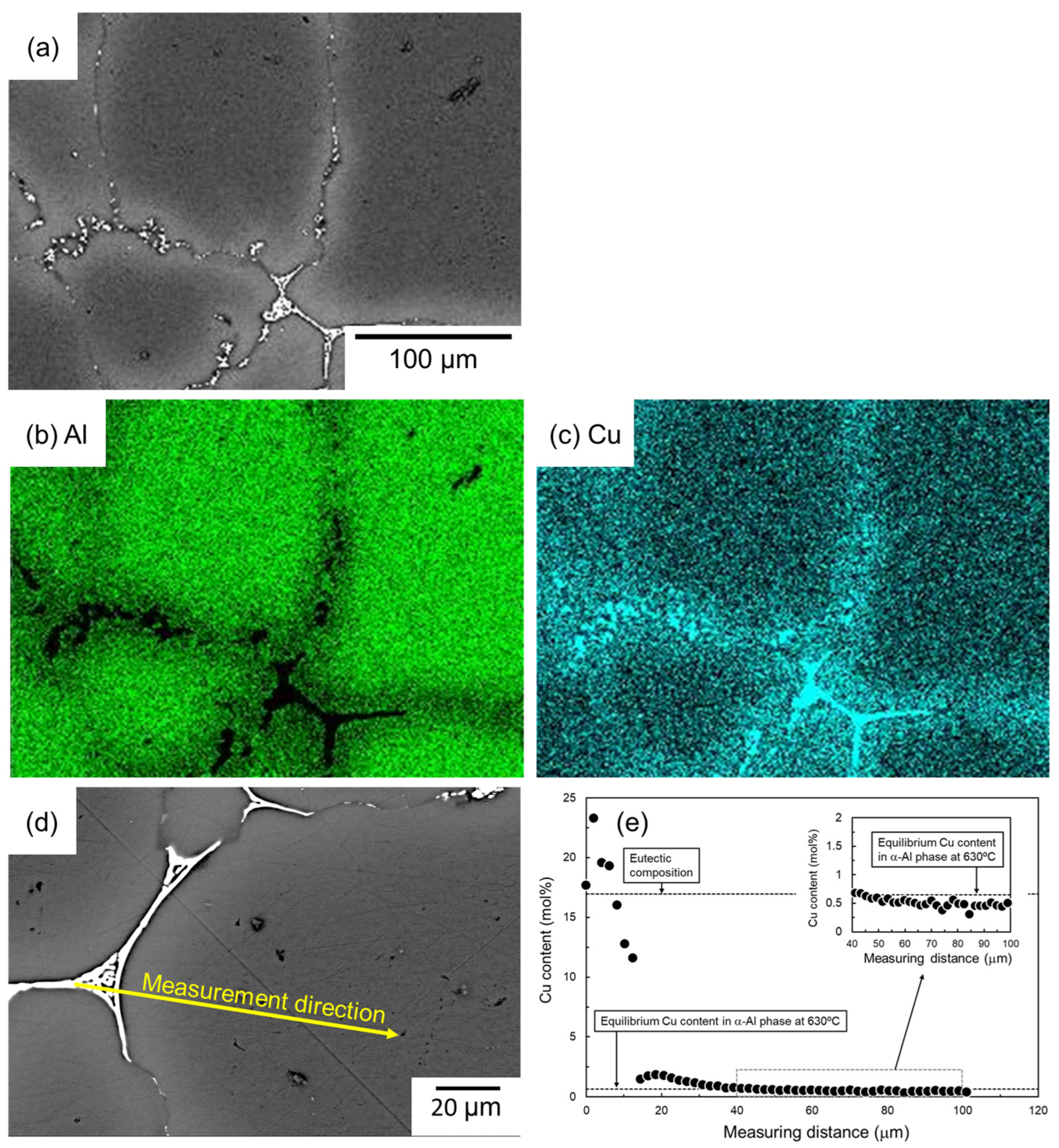
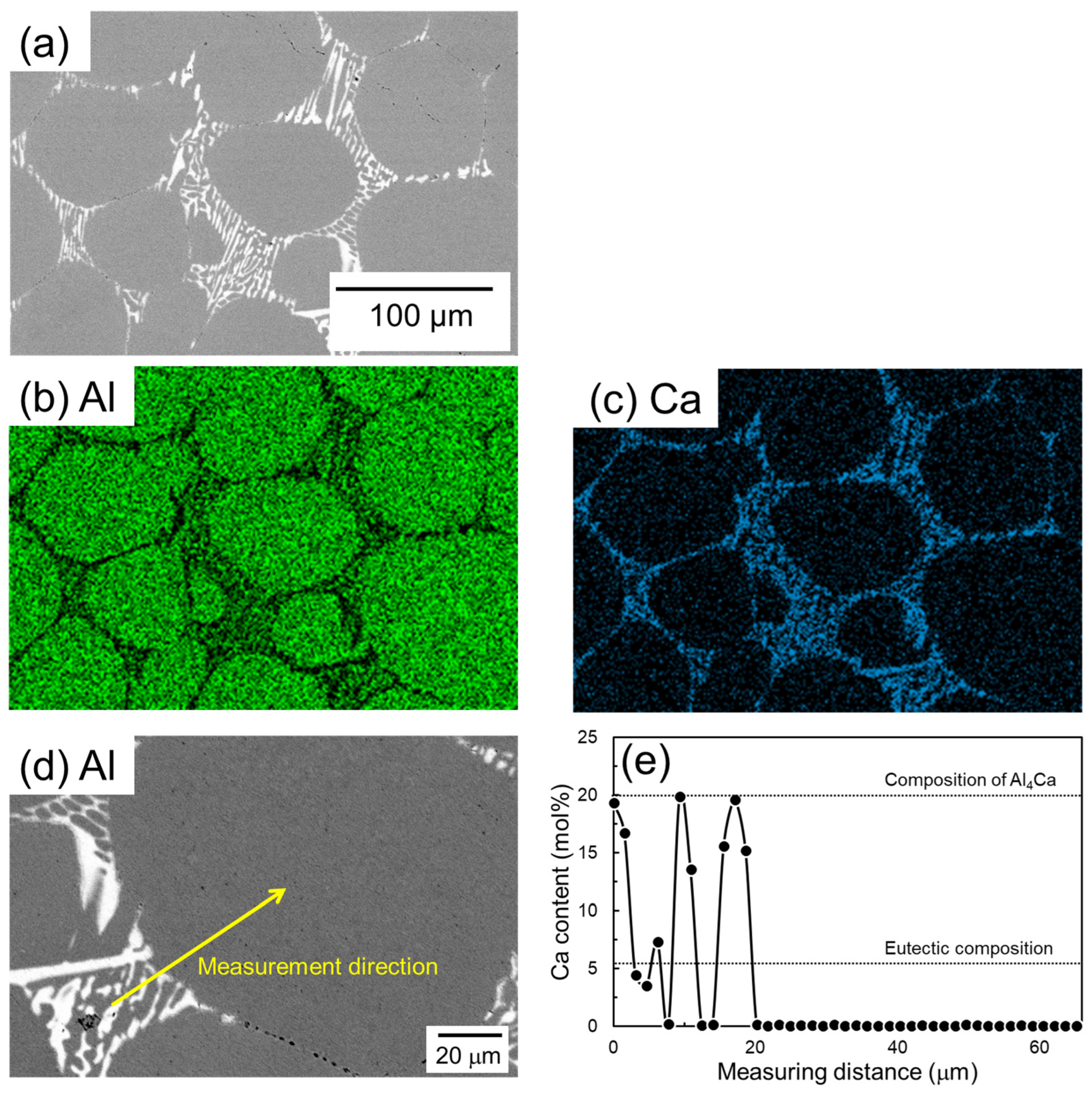
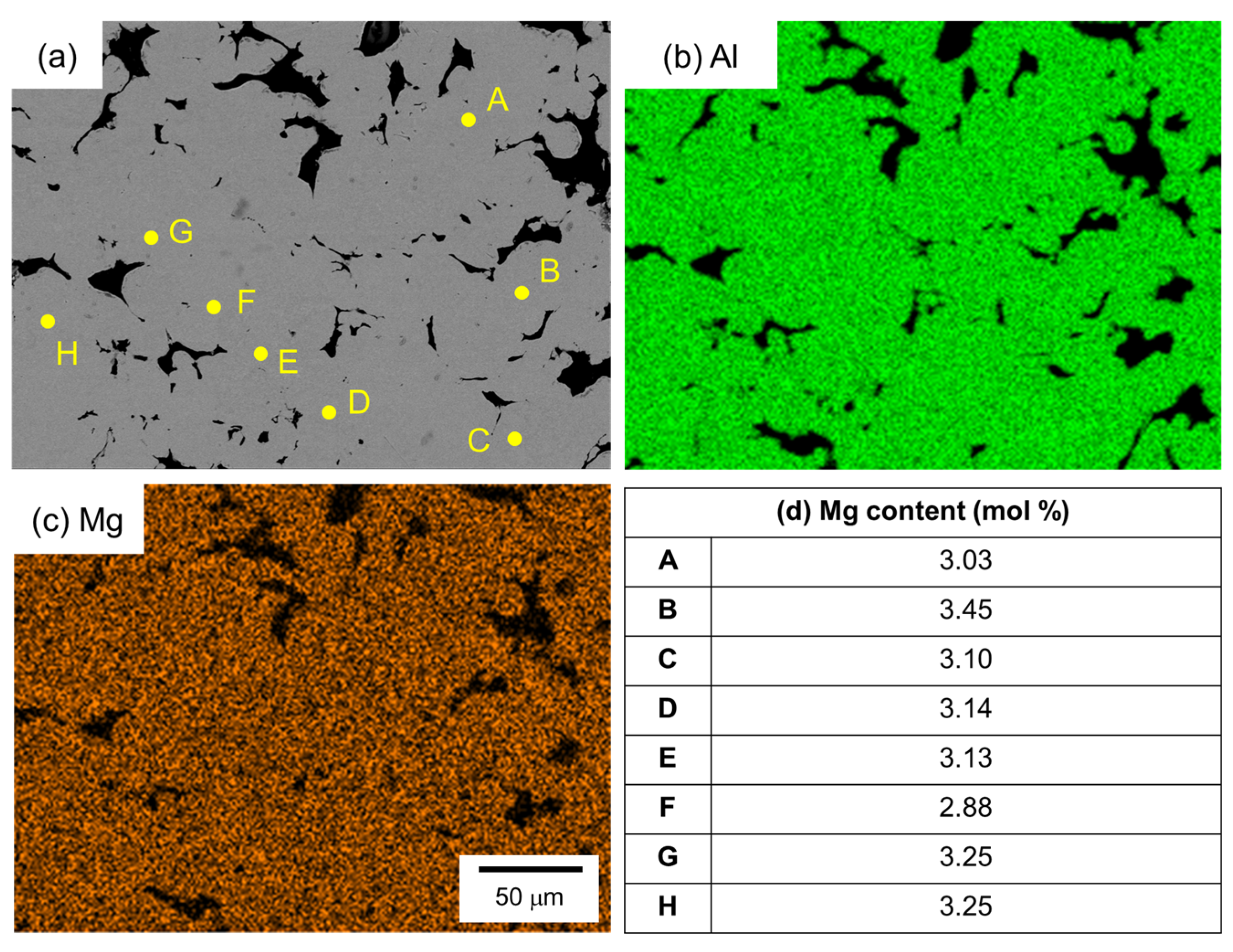
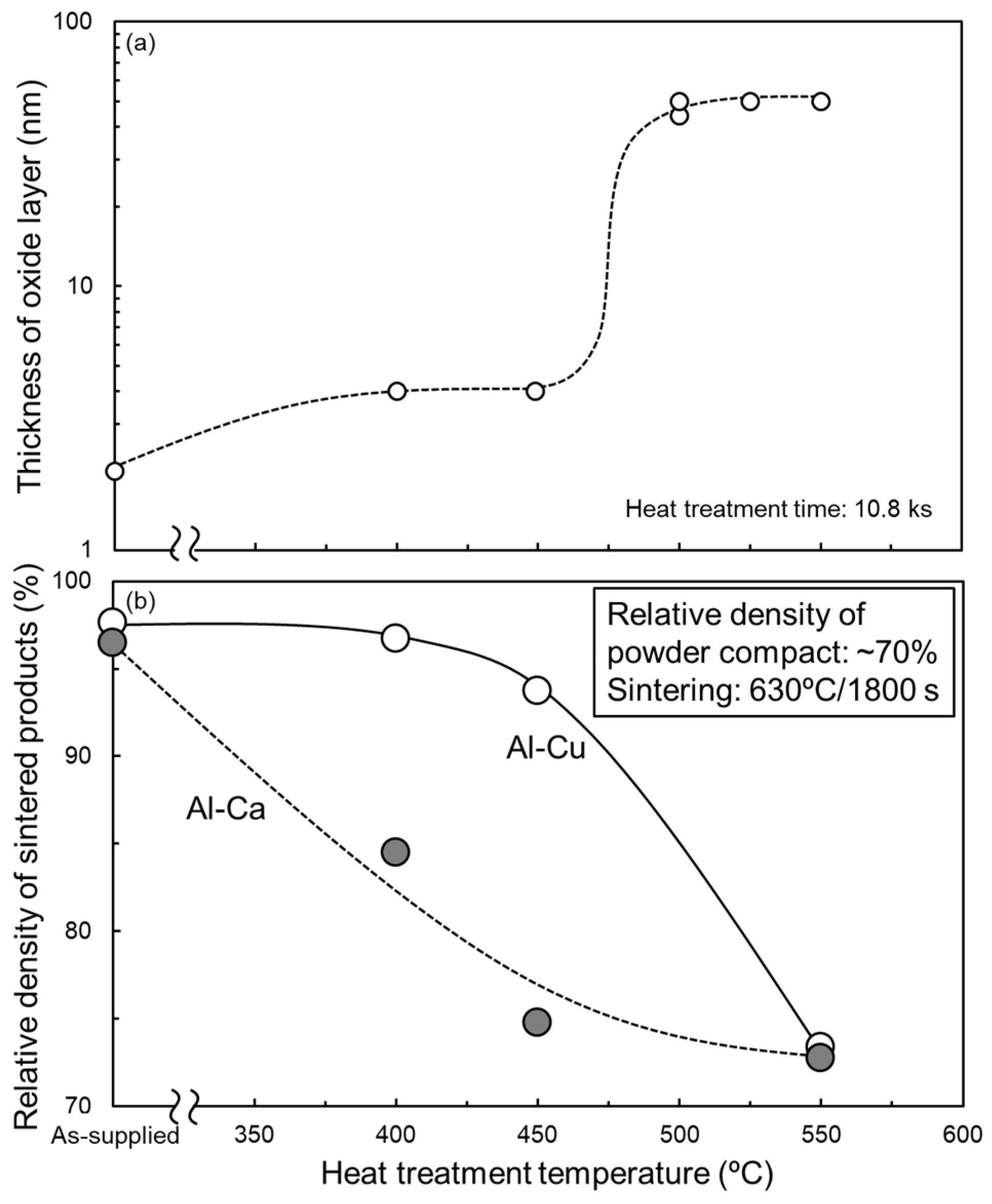
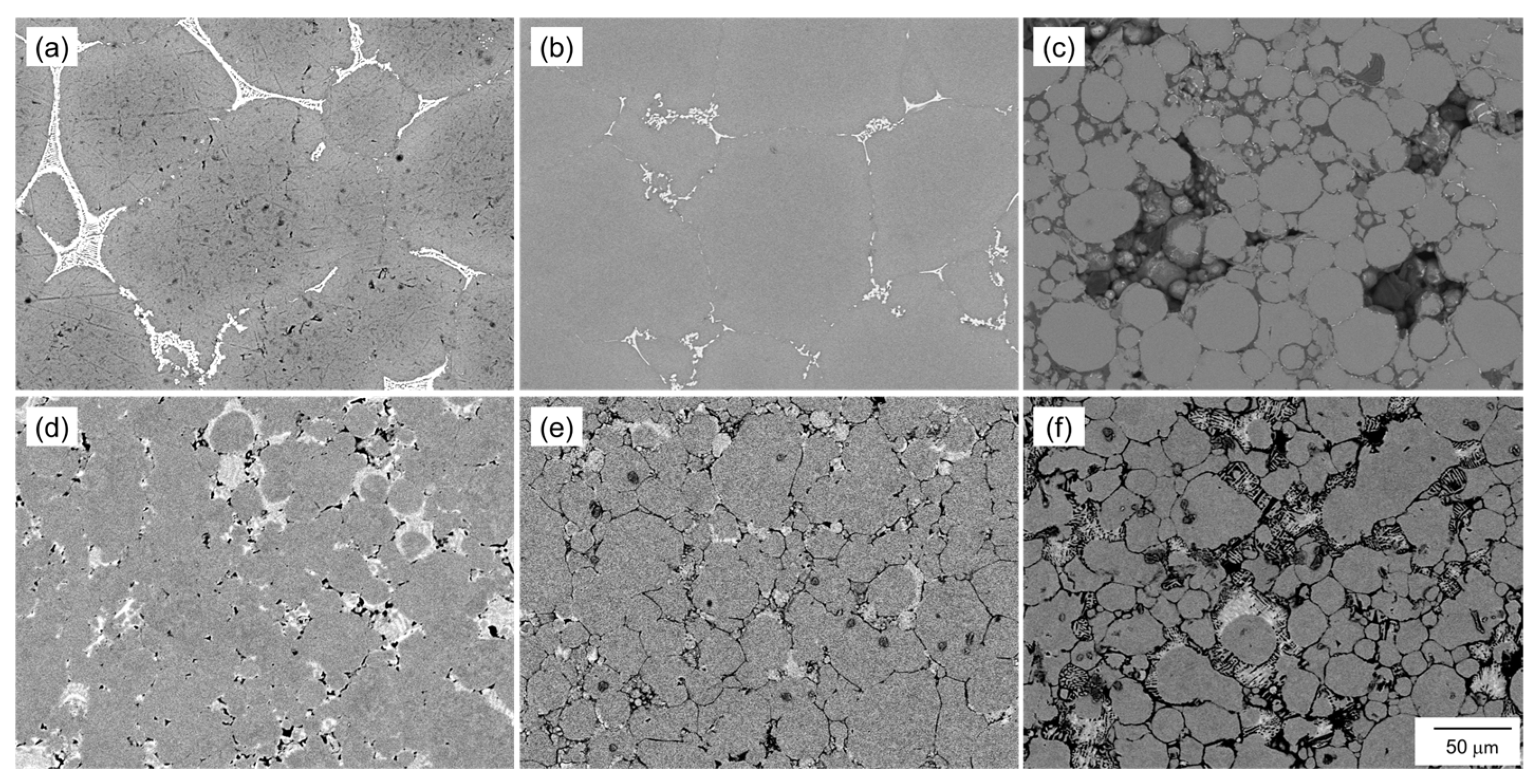


| Al-Mg | Al-Ca | Al-Cu | |
|---|---|---|---|
| Eutectic composition (mol%) | 37 | 5.5 | 17.3 |
| Eutectic temperature (°C) | 450 | 613 | 548 |
| Maximum solubility limit (mol%) | 16.5 | 0 | 2.5 |
| Alloy | Composition (mass%) | |||||
|---|---|---|---|---|---|---|
| Cu | Mg | Ca | Si | Fe | O | |
| Al-17.3 mol%Cu (Al-33 mass%Cu) | 32.77 | - | - | <0.01 | <0.01 | 0.082 |
| Al-37 mol%Mg (Al-35 mass%Mg) | - | 34.85 | - | <0.01 | <0.01 | 0.20 |
| Al-5.5 mol%Ca (Al-8 mass%Ca) | - | - | 7.85 | <0.01 | <0.01 | - |
| Condition of Al Powder | Eutectic Alloy Agent | ||
|---|---|---|---|
| Al-Cu | Al-Ca | Al-Mg | |
| As-supplied | ● | ● | ● |
| 400 °C heat-treated | ● | ● | - |
| 450 °C heat-treated | ● | ● | - |
| 550 °C heat-treated | ● | ● | - |
Disclaimer/Publisher’s Note: The statements, opinions and data contained in all publications are solely those of the individual author(s) and contributor(s) and not of MDPI and/or the editor(s). MDPI and/or the editor(s) disclaim responsibility for any injury to people or property resulting from any ideas, methods, instructions or products referred to in the content. |
© 2025 by the authors. Licensee MDPI, Basel, Switzerland. This article is an open access article distributed under the terms and conditions of the Creative Commons Attribution (CC BY) license (https://creativecommons.org/licenses/by/4.0/).
Share and Cite
Kusunoki, R.; Hayashi, H.; Matsumoto, E.; Suzuki, A.; Takata, N.; Kobashi, M.; Yoshida, A.; Hamada, T.; Mekata, M. Liquid Phase Sintering of Al Powder Using Al-X (X=Cu, Ca, Mg) Eutectic Alloy Powders: Effect of Alloy Elements and Oxide Film Thickness. Materials 2025, 18, 1755. https://doi.org/10.3390/ma18081755
Kusunoki R, Hayashi H, Matsumoto E, Suzuki A, Takata N, Kobashi M, Yoshida A, Hamada T, Mekata M. Liquid Phase Sintering of Al Powder Using Al-X (X=Cu, Ca, Mg) Eutectic Alloy Powders: Effect of Alloy Elements and Oxide Film Thickness. Materials. 2025; 18(8):1755. https://doi.org/10.3390/ma18081755
Chicago/Turabian StyleKusunoki, Ryotaro, Hideaki Hayashi, Erika Matsumoto, Asuka Suzuki, Naoki Takata, Makoto Kobashi, Akira Yoshida, Takahiro Hamada, and Moe Mekata. 2025. "Liquid Phase Sintering of Al Powder Using Al-X (X=Cu, Ca, Mg) Eutectic Alloy Powders: Effect of Alloy Elements and Oxide Film Thickness" Materials 18, no. 8: 1755. https://doi.org/10.3390/ma18081755
APA StyleKusunoki, R., Hayashi, H., Matsumoto, E., Suzuki, A., Takata, N., Kobashi, M., Yoshida, A., Hamada, T., & Mekata, M. (2025). Liquid Phase Sintering of Al Powder Using Al-X (X=Cu, Ca, Mg) Eutectic Alloy Powders: Effect of Alloy Elements and Oxide Film Thickness. Materials, 18(8), 1755. https://doi.org/10.3390/ma18081755










